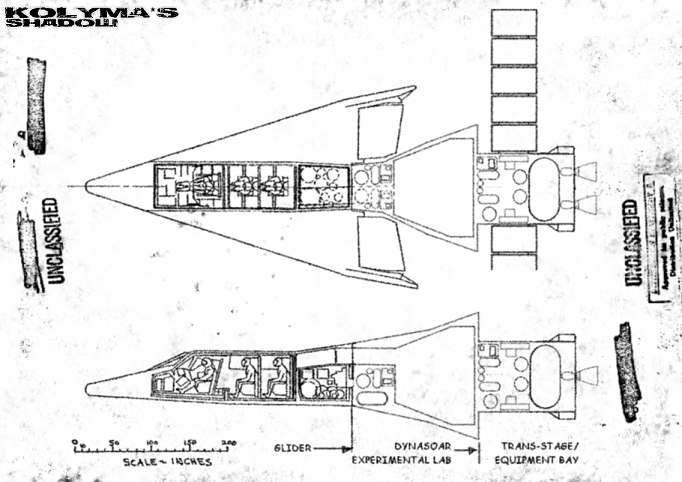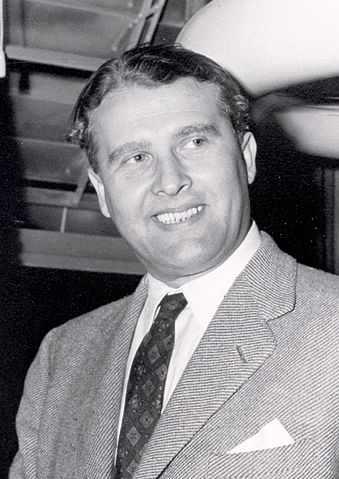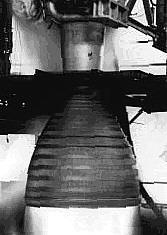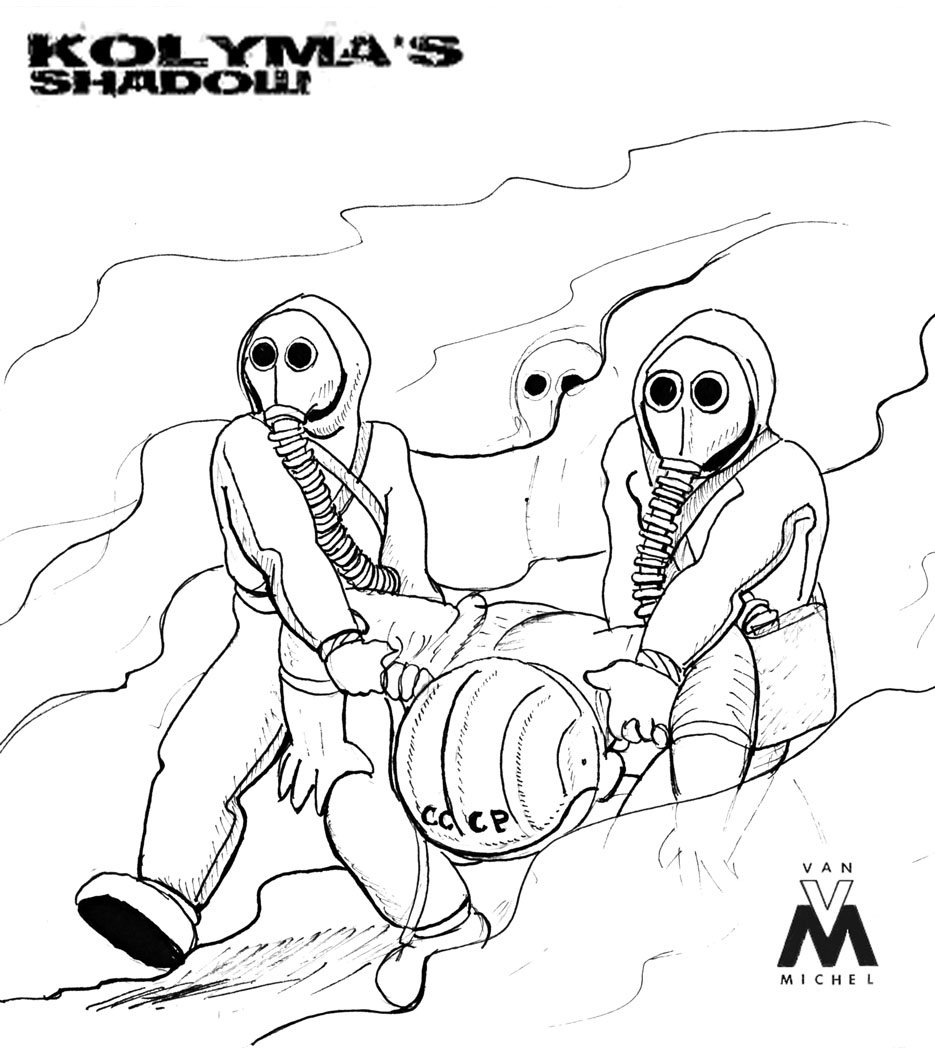Part II Post #3: Dynasoar Evolution
Even as manned Mercury flights were becoming routine, thoughts were already turning to what would follow. The shape of that future was on display on 12th August 1963 when the Dynasoar Atmospheric Test Vehicle “Diane” was carried aloft for the first time under the wing of a B-52C Stratofortress at White Sands, New Mexico. Following separation from the B-52 at an altitude of 11 000 metres and a speed of Mach 0.78, pilot Bill Dana successfully guided the ATV glider from the B-52 down to a landing on the dry lake bed, skidding to a halt after just seven minutes of free flight. Though the test objectives were modest, the pictures of the futuristic, dart-shaped spacecraft in flight inspired the public and gave a great publicity boost to the Dynasoar Program Office at Air Force Systems Command. This success was very welcome after several years in which the project had undergone a series of major changes.
Bill Dana’s Dynasoar ATV “Diana” is carried to altitude by a modified B-52 bomber for its first drop test, August 1963.
Ever since the project’s inception, the question of which launcher the spaceplane should use had been an open one. At the time of its 1960 System Review, the assumption had been that Dynasoar would boost to orbit on a modification of Martin’s Titan booster. Martin had been developing designs for an improved, hypergolic version of the Titan-I missile which could be augmented by large Solid Rocket Boosters to create a powerful launch vehicle capable of putting up to 13 000 kg into orbit. The Solid Rocket Boosters were an outgrowth of the Minuteman ICBM project, which aimed to field a force of advanced missiles capable of being stored in hardened bunkers for years at a time, fully fueled, then launched against the enemy at a moment’s notice. Such a weapon would be able to provide an instant response to any surprise Soviet attack, and the Nixon administration planned to deploy 200 of the missiles by 1964.
Regarding Titan, there were those in the Air Force who were as worried about using toxic propellants as Mishin was in the Soviet Union. During development of the Titan II ICBM there had been several accidents with the Aerozine 50 and dinitrogen tetroxide propellants, leading to concern in the Air Force that the advantages of hypergolics were not matched by the risks, especially if it was intended to place a crew atop the missile.
As an alternative to a Titan-II launcher, the Air Force had also considered combining large SRBs with an advanced hydrogen-oxygen upper stage to create the “Space Launching System”. First studied as part of Project Lunex in the late 1950s, SLS would mix-and-match small and large hydrolox cores with a variable number of SRBs to give a range of capabilities from 9 tonnes all the way up to the 160 tonnes needed for Lunex’s direct-ascent Moon missions. The hydrogen-oxygen cores would make use of the J-2 engine, development of which had started, along with the smaller RL-10, back in the late 1950s. This family of launchers was expected to be flexible, responsive, and cost-effective, but its main competition would come not from within the Air Force, but from the father of modern rocketry himself.
With its creation in 1961, the Defense Research Agency had been assigned responsibility for coordinating and rationalising the Armed Forces’ disparate launcher development programmes, and almost immediately von Braun’s Space Systems Office began pushing a new option. The design represented the culmination of the former ABMA team’s previous decade of studies, combined with work done for the Navy’s now-cancelled Triton launcher, plus the extensive design work von Braun had undertaken at Chrysler. The resulting launch vehicle (named “Minerva” for the third member of the Romans’ Capitoline Triad that also included Jupiter and Juno) would make use of a combination of kerosene-oxygen stages for liftoff, married to a selection of high-energy hydrolox upper stages. Powered by the E-1 engine that had been in development since 1957, the kerolox stages would consist of a large first stage core to which two or four smaller Liquid Rocket Boosters could be attached. These LRBs would build upon work von Braun had already started whilst at Chrysler as a potential successor for Atlas, greatly reducing the time that would be needed to deliver an operational vehicle. Both the Core and the LRBs would be powered by the E-1, meaning that early LRB launches would also provide valuable data back into the Core design effort. The hydrogen-oxygen second stage would make use of the J-2 engine which had also been planned for SLS, again taking advantage of existing development work. For high-energy geostationary or Earth escape missions, the RL-10 powered Centaur upper stage would be added. Combining the Centaur with a single LRB would create a launcher with around twice the payload capability of Atlas, whilst varying combinations of LRBs, 1st and 2nd stages would provide for a spectrum of payloads from ten tonnes up to to twenty-two tonnes.
Von Braun, never one to underestimate the political side of building rockets, had learnt his lessons since his Army team had been sidelined by Eisenhower. Even before being appointed to the DRA, he and his team began lobbying in the White House and in Congress to promote the advantages of the Minerva design. By proposing to spread contracts between Convair (the upper stage and Centaur), North American (the core stage), Chrysler (the LRBs), Roketdyne (the E-1 and J-2 engines) and Pratt and Whitney (Centaur’s RL-10 engine), von Braun had allied himself with a powerful industrial team. By making the Minerva family flexible enough to cover almost the entire range of desired capabilities, he was guaranteeing these companies government orders for years, even decades to come. In return, the combined lobbying might of a significant portion of the “Military-Industrial complex” that Eisenhower been wary of was harnessed to von Braun’s ends. This helped to counter the powerful opposition of the proponents of Solid Rocket Motors within the Air Force, since under von Braun’s proposal the main contractor for the Minuteman missile, Boeing, would gain two rocket production lines instead of just one. When combined with von Braun’s technical arguments in favour of LRBs over SRBs (including lower development costs, ease of handling, and flexibility), the opposition collapsed. Minerva was confirmed as the launcher of choice in January 1963, with plans to upgrade Titan-II with SRBs also cancelled in favour of von Braun’s rocket just a few months later.
Whilst the launcher debate was raging, a parallel discussion was ongoing regarding the role Dynasoar would perform. The spaceplane had originally been sold as a global-range bomber and high-speed, high-altitude reconnaissance platform, but with the emergence of reliable ICBMs, as well as the continuing supremacy of SAC’s gigantic bomber force, the global strike mission was no longer seen as vital. As for reconnaissance, since the shoot-down of John MacArthur’s U-2 in early 1960 the CIA had been placing more and more emphasis on gaining intelligence from spy satellites. Development of these satellites had been transferred from the Air Force to the new top-secret National Reconnaissance Office in April 1960, since which time a series of increasingly capable spysats had been developed under the Corona code-name. The Air Force felt that there was still a requirement for a manned reconnaissance plane (and in fact were secretly working on their A-12 Mach-3 jet for just this role), but as the satellites kept improving, the more traditional manned approach was becoming a harder sell on the Capitol.
In February 1963 a USAF-NACAA-DRA meeting was held in Washington DC to consider options for expanding Dynasoar’s mission capabilities. Since passing its first Design Review in June 1960, the glider aspect of the Dynasoar project had been proceeding reasonably smoothly, but it was quickly agreed that the initial one-man concept could not meet the crew size or duration needs desirable for the kind of experimental missions now being contemplated. To solve this problem it was proposed that two distinct variants of Dynasoar be created, each sharing a common glider airframe. The Mk-I variant would be a single-pilot craft including a small payload bay, which would verify the overall system performance, make short-duration reconnaissance flights, and test experimental Air Force technologies. The second version, the Mk-II, would replace the payload bay with 2-4 man passenger compartment, and be equipped for extended duration flights to investigate the feasibility of performing long-term military missions in space. This greater duration would be achieved through the use of a disposable “Mission Module”, which would house the main on-orbit propulsion, power and support systems and would be dumped before re-entry to keep heating loads on the glider within acceptable limits. Once this idea was accepted, it was quickly realised that a wide variety of systems not needed for re-entry or return to Earth could be moved to this Mission Module, giving considerable flexibility in the mission equipment that could be supported.
Although Dynasoar, equipped with an appropriate Mission Module, would have an on-orbit endurance of several days, its cramped quarters and limited payload capability restricted the usefulness on longer missions. What was needed was a more spacious, heavier “Space Base” or “Space Laboratory”, that could support large experiments and long-term crews in comfort. Based on a number of studies dating back to the 1950s, the conference proposed a step-by-step development of a manned space platform capability.
The starting point would be effectively an expansion of the planned Mission Module into a crewed space lab, with the first mission targeted for 1966. Weighing in at somewhere between 5 and 7 tonnes, this Dynasoar Experimental Laboratory (DEL) would be launched along with a manned Dynasoar atop a Minerva rocket, removing the need for complicated on-orbit rendezvous and docking capabilities. Once in space, the crew of the Dynasoar Could transfer to the DEL via an internal tunnel at the rear of the spaceplane. They would spend the next ten-to-twenty days living and working in the DEL, before returning to Dynasoar with the results of their experiments and using the DEL’s engines to put both the lab and the spaceplane into a re-entry trajectory. The Dynasoar would the separate for re-entry and land as normal, whilst the DEL would be destroyed in the atmosphere.
Assuming the DEL confirmed that men could live in space for extended periods, it would be followed up by the Dynasoar Orbital Station (DOS). This would be a 20 tonne module, to be launched on its own Minerva rocket some time around 1968. Once in orbit, it would be able to support multiple month-long Dynasoar missions (assuming the problems of rendezvous and docking had been solved), carrying out a variety of life sciences and Earth observation experiments. If successful, DOS could be followed by other stations, perhaps using on-orbit assembly and replenishment to support missions of several months.
Early concept drawing for the Dynasoar Mk-II with the Dynasoar Experimental Lab.
(Based upon this image)
One group still not happy with the direction of America’s manned space programme were the “Capsule Faction” of NACAA, led by Max Faget. Following the successful development of their Mercury design, they had assumed that the next logical step would be “Mercury Mk.II”, an expanded, 2-man capsule with on-orbit manoeuvring capability. On top of the many technical advantages they claimed for capsules over winged spacecraft, the development costs for this approach would be a fraction of what was needed for Dynasoar. It was, to them, the obvious choice.
Although by now firmly committed to the Dynasoar, there were those in the Air Force who sympathised with the NACAA position. In particular, one area where Dynasoar came up short was for potential high orbit or deep space missions. Here Dynasoar was limited by the maximum heating, and therefore maximum re-entry speed, which could be supported by its radiatively cooled skin and thin, vulnerable wings. In contrast, a blunt capsule would be able to make use of an ablative heat shield similar to Mercury’s, allowing missions to extremely high orbits, or even circum-lunar flights.
It was this possibility for future deep-space flights that led von Braun to throw his weight behind Faget and argue in favour of a detailed design study for a future space capsule. Despite resistance in the Pentagon and in Congress to the idea of funding two parallel manned spacecraft, in late 1963 the two wiley engineers succeeded in getting approval for a joint NACAA-DRA project to investigate designs for a 3-man space capsule for deep space missions. Although a far cry from the full vehicle development programme Faget craved, these studies kept the door open for future alternatives to Dynasoar, even as the spaceplane began taking its first flights.






